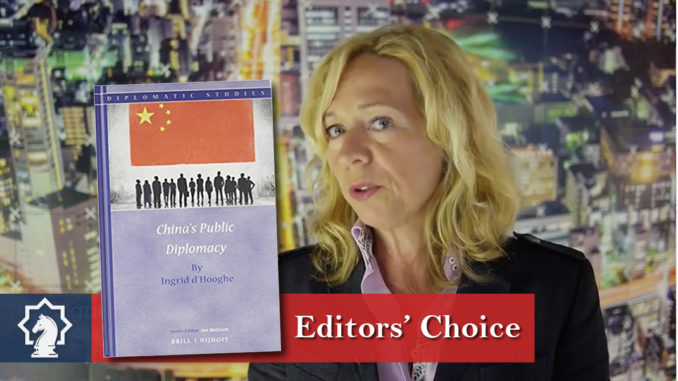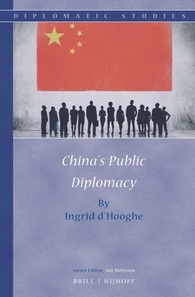

I In China’s Public Diplomacy, author Ingrid d’Hooghe contributes to our understanding of what constitutes and shapes a country’s public diplomacy, and what factors undermine or contribute to its success. China invests heavily in policies aimed at improving its image, guarding itself against international criticism and advancing its domestic and international agenda. This volume explores how the Chinese government seeks to develop a distinct Chinese approach to public diplomacy, one that suits the country’s culture and authoritarian system.
Based on in-depth case studies, it provides a thorough analysis of this approach, which is characterized by a long-term vision, a dominant role for the government, an inseparable and complementary domestic dimension, and a high level of disconnectedness with China’s overall foreign policy and diplomacy.
Table of contents
- Introduction
- The Case of China’s Public Diplomacy
- The Design of the Study: Questions and Assumptions
- The Selection of Case Studies
- Overview of the Chapters
Chapter 1
- How to Understand Public Diplomacy: An Analytical Framework
- The Concept of Public Diplomacy
- The Challenges of Public Diplomacy 2.0
- Public Diplomacy and Soft Power
- Public Diplomacy and Propaganda
- Subsets of Public Diplomacy
- The Domestic Dimension and the Role of Diasporas
- The Analytical Framework
- Dimension I: Actors and Decision-making
- Dimension II: Public Diplomacy Content
- Dimension III: Public Diplomacy Instruments
- The Impact of a Country’s Political System
- The Impact of Culture on Public Diplomacy
- Conclusion
Chapter 2
- Assets and Liabilities for China’s Public Diplomacy
- The Importance of Culture
- China’s Authoritarian System
- Media and Social Media Censorship
- Human Rights and Tibet
- The Lack of Cultural Freedom
- China’s Economic Rise
- The China Model
- China’s Environmental Challenges
- The Copenhagen Summit
- China’s Foreign Policy and Diplomacy
- The Concepts of Harmonious World and Chinese Dream
- China’s Military Rise and Cyber-Security
- Chinese Tourists
- Conclusions
Chapter 3
- The Chinese Debate on Public Diplomacy
- The Introduction of Soft Power and Public Diplomacy in China
- The Chinese Understanding of Public Diplomacy
- Defining Public Diplomacy
- New Public Diplomacy and Public Diplomacy 2.0
- Public Diplomacy and Propaganda
- Soft Power
- Cultural and People’s Diplomacy
- The Domestic Dimension
- Sources of Soft Power
- Chinese Culture as a Source of Soft Power
- The China Model as a Source of Soft Power
- The Impact of Culture on Public Diplomacy
- Challenges and Constraints
- Conclusions
Chapter 4
- China’s Public Diplomacy System
- The Growing Diversity of Actors
- National State Actors
- The State Council Information Office
- The Ministry of Foreign Affairs
- Chinese Embassies and Missions Abroad
- The Ministry of National Defense and the PLA
- Other Ministries
- China’s Leaders
- The Chinese Communist Party
- The Chinese People’s Political Consultative Conference
- Subnational State Actors
- Non-State Actors
- People’s Diplomacy Organizations
- Intellectual Elites and Academic Institutions
- Volunteers and Celebrities
- Companies
- Overseas Chinese
- Consequences of the Diversification of Actors
- Public Diplomacy Instruments
- The Media
- The New Media
- Foreign Media
- Cultural Institutes and Activities
- Educational Institutes and Activities
- Confucius Institutes
- Foreign Aid
- China’s Public Diplomacy Budget
- Conclusions
Chapter 5
- China’s Public Diplomacy Strategies: Asia and Africa
- China’s Public Diplomacy in Asia
- South and Southeast Asia
- Central Asia
- Northeast Asia: Japan and South Korea
- China’s Public Diplomacy in Africa
- Analysis and Conclusions
Chapter 6
- Proactive Public Diplomacy: Events
- The Beijing Olympic Games and the Shanghai World Expo
- The 2008 Beijing Olympic Games
- Winning the Olympic Bid
- Olympics’ Public Diplomacy
- Ceremonies
- Evaluation of the Event
- Analysis
- The 2010 Shanghai World Expo
- Winning the Expo Bid
- World Expo Public Diplomacy
- Evaluation of the Event
- Lessons Learned
- Analysis
- Conclusions
Chapter 7
- Reactive Public Diplomacy: Crises
- The SARS Epidemic, Product Scandals, and the Wenchuan Earthquake
- The 2003 SARS Epidemic
- The Unfolding of the Crisis
- Public Diplomacy Actions
- Analysis
- Lessons Learned
- Food and Toy Safety Crises
- The 2007 Pet Food and Toys’ Scandals
- The 2008 Contaminated Milk-Powder Scandal
- Analysis
- The 2008 Wenchuan Earthquake
- The Role of the Domestic Media
- The Role of the PLA
- Analysis
- Conclusions
Chapter 8
- The Reception of China’s Public Diplomacy
- Measuring the Effect of Public Diplomacy
- Global Views of China
- Interpreting Poll Results
- Conclusions
Conclusion
- The Importance China Attaches to Public Diplomacy
- The Impact of China’s Authoritarian Political System
- State-C contentedness
- Media Control and Censorship
- Other Impacts
- The Impact of Chinese Culture on Public Diplomacy
- A Strategic and Holistic Approach
- Evolution and Challenges
- Issues for Future Research













